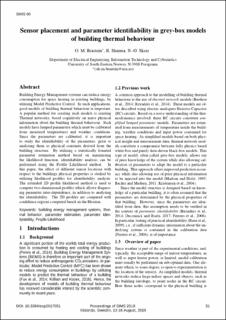Sensor placement and parameter identifiability in grey-box models of building thermal behaviour
Journal article, Peer reviewed
Published version
Permanent lenke
https://hdl.handle.net/11250/2641749Utgivelsesdato
2019Metadata
Vis full innførselSamlinger
Sammendrag
Building energy management systems can reduce energy consumption for space heating in existing buildings, by utilising Model Predictive Control. In such applications, good models of building thermal behaviour is important. A popular method for creating such models is creating Thermal networks, based cognitively on naive physical information about the building thermal behaviour. Such models have lumped parameters which must be calibrated from measured temperatures and weather conditions. Since the parameters are calibrated, it is important to study the identi?ability of the parameters, prior to analysing them as physical constants derived from the building structure. By utilising a statistically founded parameter estimation method based on maximizing the likelihood function, identi?ability analysis can be performed using the Pro?le Likelihood method. In this paper, the effect of different sensor locations with respect to the buildings physical properties is studied by utilising likelihood pro?les for identi?ability analysis. The extended 2D pro?le likelihood method is used to compute two-dimensional pro?les which allows diagnosing parameter inter-dependence, in addition to analyzing the identi?ability. The 2D pro?les are compared with con?dence regions computed based on the Hessian.

